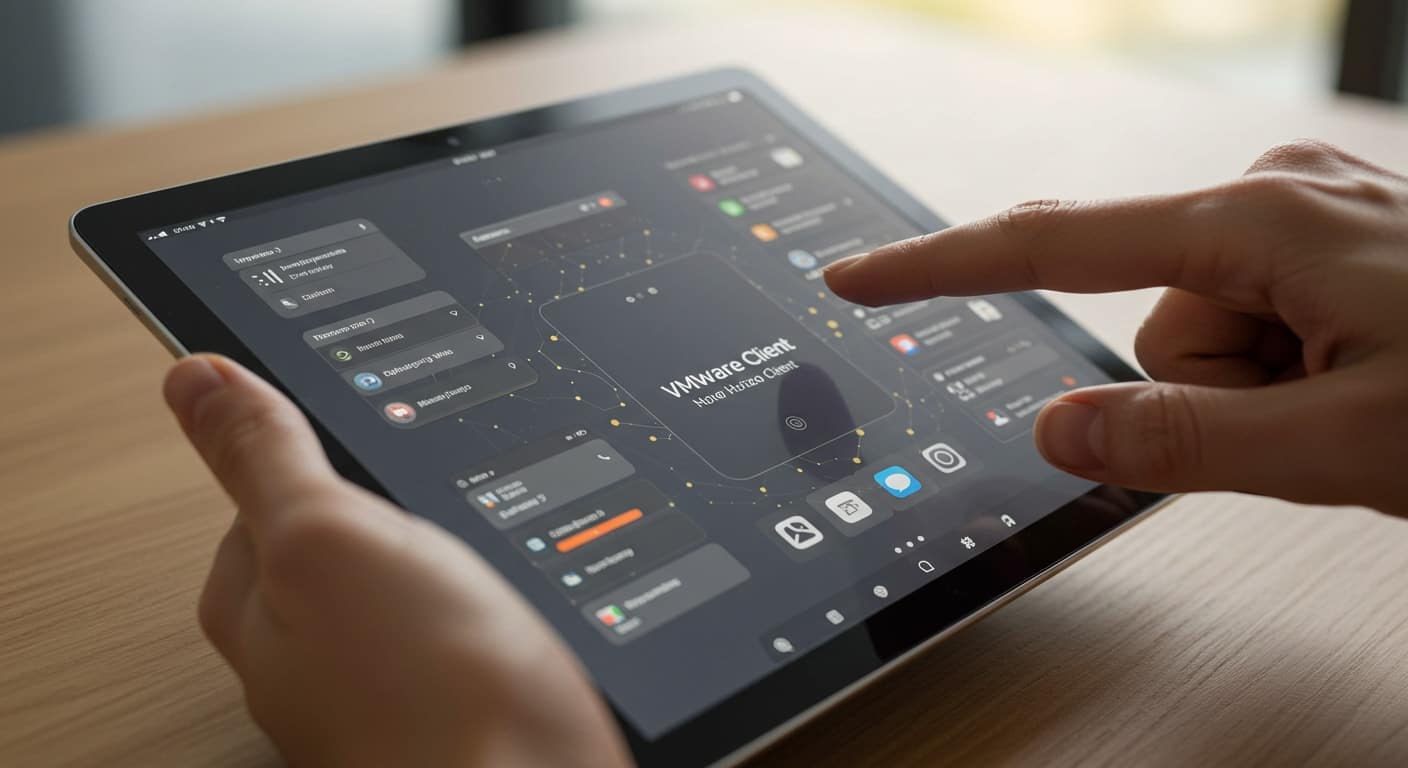When most people talk about remote work or hybrid learning, they think about video calls, cloud apps, or file sharing. But the real engine behind a smooth remote experience often runs much deeper—powered by something called virtual desktops. And one of the most common ways to access those desktops is through a tool known as the VMware Horizon Client.
If you’ve ever logged into a digital workspace from your laptop or tablet, there’s a good chance this software was doing the heavy lifting. It helps users access secure desktops and apps hosted in remote environments—without needing to be physically at the office or school.
But what exactly is VMware Horizon Client? How does it work, and what are its limitations? And more importantly, is it still the best way to deliver remote desktops in 2025?
We’ll break it all down—starting with what the client actually is and how it fits into the bigger picture.
What is VMware Horizon Client?

The VMware Horizon Client is a piece of software that allows you to connect to a virtual desktop environment hosted in a data center or the cloud. When you launch it, you’re essentially opening a window into a desktop that doesn’t live on your device—it’s hosted remotely and streamed to you over the internet.
This client is part of the larger VMware Horizon platform, which delivers virtual desktops and applications to all kinds of endpoint devices. Whether you’re on Windows, macOS, Linux, Chrome OS, or even Android, the Horizon Client helps maintain a consistent user experience across the board.
Here’s what it’s built to do:
- Connect you to a centralized desktop or specific app without storing data locally
- Provide a consistent digital workspace, regardless of the device you’re using
- Support secure access to internal systems, with data kept safely on the server
Supported platforms include:
- Windows
- macOS
- Linux
- Chrome OS
- Android and iOS
To use it, the client must be installed on the device, and that’s where some friction can appear. Updates, compatibility, and configuration can introduce overhead that not every organization is equipped to manage easily.
Key Components of the VMware Horizon Environment
To understand how VMware Horizon Client functions in context, it helps to know the broader environment it connects to. This isn’t a standalone app—it’s part of a layered system designed to deliver a full desktop experience from a remote location. Two elements are especially central: the Horizon Client and the Connection Server.
Horizon Client and View Desktops
The Horizon Client is the interface installed on your device. Once opened, it connects you to a view desktop, which is essentially a virtual machine running in a secure location—usually a cloud environment or data center.
These view desktops behave just like a typical operating system. You might be running Windows, Linux, or something else entirely, but the environment isn’t hosted on your physical device. Instead, it’s streamed to your screen from a central server.
This approach allows users to work from different endpoint devices—a laptop at home, a tablet while traveling, or a campus desktop—all while maintaining a consistent experience. Everything from apps to files stays in one place, reducing reliance on local storage and making IT management a bit more centralized.
Connection Server and Authentication
Behind the scenes, the View Connection Server acts as the gatekeeper. It manages authentication, checks user credentials, and determines what virtual resources a person can access.
When you log in through the Horizon Client, the connection server handles the handshake. It confirms your identity, enforces security rules, and ensures that only permitted users reach the environment. This is where session control happens—who’s connected, how long they stay logged in, and what kind of data they’re allowed to work with.
Sensitive information isn’t stored locally. Instead, it stays within the network, which is one reason enterprises and educational institutions use Horizon in the first place. The setup supports compliance, keeps things clean from a data privacy perspective, and gives administrators tight control over the access experience.
How VMware Horizon Works in Practice

Understanding the structure is one thing. Seeing how it operates day to day brings it into clearer focus. VMware Horizon isn’t plug-and-play in the way many modern tools are. It’s built for control, scale, and tight integration with enterprise systems—which makes it powerful, but not without trade-offs.
Deployment and Infrastructure
VMware Horizon’s architecture depends on a layered backend, typically hosted in a data center or private cloud. At the core of this setup are virtual machines, managed through VMware’s vSphere client, which act as the desktops users log into.
Each of these virtual desktops is configured within a larger infrastructure that includes network routing, storage, and system resource allocation. The IT team defines templates for these machines—what software is included, how much memory they get, which users they serve—and then scales that environment as needed.
It’s not a small lift. Setting up Horizon means configuring authentication policies, assigning resources, and integrating with systems like Active Directory. In high-volume environments, performance tuning and load balancing also come into play.
When done right, it gives organizations deep control over how digital workspaces behave. But it also assumes you have the expertise—and time—to manage that complexity.
User Access and Experience
From the user’s side, it looks simpler. You launch a browser or local Horizon client, enter your credentials, and the system connects you to your virtual desktop. If everything’s running properly, the switch is fairly seamless.
The performance varies depending on your network, device specs, and configuration. On modern systems, the experience can feel native. But on older devices, or in bandwidth-constrained environments, things like lag, resolution drops, or freezing apps can get in the way.
Compatibility is wide but not always even. Horizon supports Linux, Chrome OS, Android, and more, but how well it performs can differ from one platform to another. Users may find it smoother on Windows machines than on Chromebooks or tablets, particularly when dealing with graphics-heavy applications.
Pros and Cons of the VMware Horizon Client
Below is a breakdown of the strengths and trade-offs of using VMware Horizon Client in a typical organization.
| Pros | Cons |
|---|---|
| Strong integration with VMware ecosystem | Can be complex to deploy and manage |
| Secure access to centralized desktops and applications | Requires ongoing infrastructure maintenance |
| Compatible with a wide range of endpoint devices | Performance can vary across platforms and network speeds |
| Supports centralized IT control and user policy enforcement | Local client installation and frequent updates can add friction |
| Helps with data protection and compliance in enterprise environments | Less agile for organizations needing quick or browser-based deployment |
Who Uses VMware Horizon and Why?
The VMware Horizon platform is widely used in sectors that demand centralized control, strict compliance, and broad access to desktop resources. Its strongest footholds are in large enterprises, higher education institutions, and government agencies.
In higher ed, Horizon is often used to deliver virtual computer labs, giving students access to software from anywhere—even when the physical campus is closed. For corporate environments, it’s a go-to solution for enabling remote teams to access internal systems without storing sensitive data on personal devices. Government organizations lean on its centralized structure to meet regulatory requirements and safeguard high-risk virtual environments.
Common use cases include:
- Remote onboarding and employee training
- Bring Your Own Device (BYOD) support across varied hardware
- Regulated industries needing strict access control and compliance adherence
Its popularity comes from its ability to scale, enforce policy, and manage user sessions with precision. Many users appreciate the control it offers IT teams, especially in environments where the stakes are high and flexibility is less of a priority. But control comes with cost—and complexity. That becomes clearer when you look at the system’s inherent limitations.
Limitations in the Current Horizon Model
VMware Horizon offers a lot of control, but that control comes with complexity. For many organizations, especially those without deep IT resources, the trade-offs are hard to ignore.
Here are some of the most common limitations:
- Device compatibility issues
Horizon doesn’t always work smoothly across all endpoint devices. Chromebooks, older laptops, or tablets can struggle with performance, especially when handling high-resolution visuals or specialized software. - Heavy infrastructure dependency
The system relies on a well-built backend—including data centers, network stability, and proper configuration. Without that, things slow down quickly or break altogether. - Token-related fragility
Horizon uses session tokens for authentication. If something goes wrong—like an expired token or a missed handshake—the session might fail with no clear reason, frustrating users. - Client installation and updates
The Horizon client must be installed on each device. Keeping that client up to date across distributed teams becomes the responsibility of the user or IT staff, increasing overhead and risk. - Security maintenance gaps
With a locally installed client, there’s always a risk of missed patches or delayed updates, which can create security vulnerabilities over time. - Performance bottlenecks with demanding apps
Horizon can struggle to deliver a smooth experience for resource-intensive apps like video editing tools or 3D modeling software—especially when running in hybrid or cloud environments.
While Horizon remains a powerful solution, these limitations can weigh heavily on organizations that value speed, simplicity, and ease of access. If you’re managing a smaller team or supporting a mixed-device environment, these drawbacks may be more than just inconveniences—they could slow down your entire operation.
A Modern Alternative: Apporto’s Browser-Native Architecture

Legacy systems like VMware Horizon served their purpose—but the world has shifted. What teams need now is flexibility without complexity. That’s where Apporto comes in.
Apporto rethinks virtual desktops for a cloud-first world. It removes the traditional hurdles—lengthy setups, heavy infrastructure, and constant patching—and replaces them with something lighter, smarter, and built for the way you work now.
Zero-Install, Browser-Based Access
One of Apporto’s biggest advantages? No installations. No local clients. No headaches.
Everything runs directly in your browser. Just log in, and you’re instantly connected to your full desktop or app environment. There’s no need to worry about device compatibility or operating system quirks. Whether you’re using a Mac, Windows PC, Chromebook, or even a tablet, Apporto just works.
This setup removes technical barriers for users, streamlines IT workflows, and reduces risk. Because nothing’s installed locally, security is easier to manage. Data stays in the cloud—never on the device—which makes compliance and audit trails far more straightforward.
With built-in support for most devices and seamless access to cloud-based apps, Apporto provides a responsive, modern experience without the usual overhead. It’s the kind of technology shift that feels obvious—once you see it in action.
Efficiency and Cost Benefits
Apporto simplifies deployment by removing most of the moving parts. You don’t need to build out expensive infrastructure or maintain complex management tools. It’s fast to roll out and scales easily across teams, departments, or entire institutions.
There’s also the financial side. Apporto offers predictable pricing whether you run in the cloud, on-premises, or in a hybrid setup. No surprise fees, no complicated licensing. That alone makes it appealing to organizations trying to stay within budget.
Because it’s built to reduce overhead, you’ll also cut down on routine IT tasks. No more patching clients, troubleshooting installs, or explaining why someone’s remote access isn’t working. You get fewer support tickets, faster resolutions, and more time back to focus on things that actually move your business forward.
When you eliminate unnecessary maintenance, the benefits ripple outward—from IT admins to end users and the organization as a whole.
Summary: Choosing the Right Virtual Desktop Solution for the Future
VMware Horizon is a well-known solution, and it continues to serve many organizations well—particularly those with large IT teams and tightly controlled environments. Its system architecture offers power, but that power comes at a cost: complexity, overhead, and performance gaps on less powerful devices.
Apporto takes a different path. It’s lean, flexible, and designed to meet today’s access demands without overburdening your IT team. You don’t have to install anything, manage clients, or fine-tune network resources just to deliver a good user experience.
When you step back and evaluate what really matters—secure access, strong performance, predictable costs—it becomes easier to create a VDI strategy that works not just today, but in the future.
Apporto is a modern desktop platform for modern needs. It’s not just another alternative—it’s a smarter way to deliver technology that works.
Ready to Rethink Your VDI Strategy?
If you’re ready to move away from the weight of legacy systems, it might be time to take a closer look at Apporto.
Whether you’re managing a university, a growing business, or a distributed workforce, Apporto gives you a virtual desktop platform that’s simple to manage, secure by design, and easy for end users to adopt.
Visit our site to launch a demo, check the documentation, or contact our team directly. We’re here to help—whether you need technical support, want to explore integration options, or just want to see how it all works.
Better virtual access starts here.


